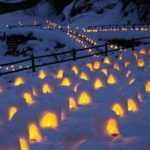 Nestled on the edge of a national park, Nikko is a small town where travellers can experience a rare side of Japan where history and nature perfectly blendtogether in the heart of Tochigi Prefecture. In the early 8th century, Nikko was the backbone of Buddhist and Shinto worship in Japan. To this day it remains one of the country’s most popular spiritual destinations, but also caters to those looking to experience nature in Japan and a little bit of relaxation with its surplus of natural hot springs.
Nestled on the edge of a national park, Nikko is a small town where travellers can experience a rare side of Japan where history and nature perfectly blendtogether in the heart of Tochigi Prefecture. In the early 8th century, Nikko was the backbone of Buddhist and Shinto worship in Japan. To this day it remains one of the country’s most popular spiritual destinations, but also caters to those looking to experience nature in Japan and a little bit of relaxation with its surplus of natural hot springs.
In winter, the many sights become dusted with pure white snow, making Nikko’s attractions even more enchanting. Being the perfect overnight destination only 2 hours from Tokyo on a Tobu Railway express train, pack your camera and get ready to strike a pose – here is a list of Nikko’s 5 most photogenic places you must add to your visit to Nikko.
Yunishigawa Onsen Kamakura Festival
Tucked away in the greenery behind the mountains on the northern banks of Nikko’s iconic Lake Chūzenji, lies the small hot springs town known as Yunishigawa Onsen. The town is said to be the final settling place of a legendary clan of Samurai warriors who claimed the land rich with natural onsen, thus why it is now a hot springs town.
Each winter, from early February to early March, the small town celebrates the Yunishigawa Onsen Kamakura Festival, where hundreds of small Kamakura (igloos) fill the streets, making this quiet mountain town come alight with candlelight. There are also fun activities on offer such as snow rafting and igloo making experience. At the festival, you can even book a private igloo equipped with a BBQ for an exclusive dinner. As Yunishigawa Onsen is known for its hot springs, the perfect way to end the day here is with a warming soak in one of the town’s many onsen.
Kazura Bridge
Honke Bankyu is a traditional Japanese Ryokan established over 350-years ago in 1666. It is now run by the 25th generation of the family and offers travellers a unique place to enjoy a traditional Japanese ‘minshuku’ (guesthouse) experience. One of the Ryokan’s most notable points is the Kazura Bridge – a vine-rope bridge that connects the main building to a restaurant on the other side of the river. In winter, the place transforms into a mystical landscape with the bridge and nature juxtaposed with the beautiful icefalls that form at the riverside. After dark the bridge is lit up, creating a glowing path of lights on the bridge, giving you the feeling that you are travelling in time.
Kegon falls
After a leisurely bus ride through the lush nature of the national park from Nikko’s centre, you will find yourself at Nikko’s iconic Kegon Falls. Standing at almost 100-metres, this waterfall is known as one of the three most beautiful in Japan and offers dramatic seasonal views all year round. In winter, the waterfall freezes over, creating a unique spectacle of ice. Visitors can see the frozen waterfall up close from the observation deck, or even take an elevator to the bottom to look up at the frozen waterfall from below.
Snow Trekking at the frozen Unryu Keikoku Ravine
Hidden deep within the lush nature and nestled between two rugged mountain peaks of Nikko is Unryu Keikoku, a narrow ravine whose name translates to the ‘Cloud Dragon Valley’. In winter, the gentle falls are transformed into an amazing sight of thousands of hanging daggers of ice with tall and thick ice pillars. The ravine is reachable in a pleasant 2-hour hike (approximately 9kms) through the snowscape. You will need to use crampons for part of the trail, so it is best to join a guided tour through the area. The best timing to see the frozen wonderland is from the end of December to early March when the temperatures reach well below freezing.
Shinkyo Bridge and Toshogu Shrine
With Nikko’s long history of Buddhist and Shinto worship in Japan, it stands as home to several of Japan’s most culturally significant UNESCO World Heritage sites. These include the ancient Nikko Toshogu Shrine deep in the forest and Futarasan Shrine with its iconic Shinkyo Bridge. With the heavy snow that sets in each winter, these sites are transformed into a historical winter wonderland. The Shinkyo Bridge is particularly memorable – the elegant arc that connects the banks of the Daiya River painted with vermilion and black lacquer contrasts against the white snow.
Nikko Toshogu Shrine which was built in dedication to Japan’s most famous samurai leader, Tokugawa Ieyasu, is considered to be the grandest of the sights in Nikko. There are many ornate structures on the shrine’s grounds, including a towering five-storey pagoda, the shrine is known for its intricate and colourful carvings decorated with gold leaf that decorate its many sacred structures – which stand out vividly against the white snowfall of winter.















